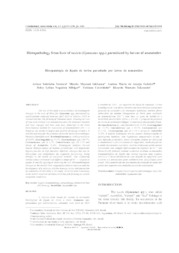Histopathology from liver of tuvira (Gymnotus spp.) parasitized by larvae of nematodes.
Histopathology from liver of tuvira (Gymnotus spp.) parasitized by larvae of nematodes.
Author(s): VENTURA, A. S.; ISHIKAWA, M. M.; GABRIEL, A. M. de A.; SILBIGER, H. L. N.; CAVICHIOLO, F.; TAKEMOTO, R. M.
Summary: Abstract: The aim of this study was to evaluate the histological changes in the liver of thirty-five Gymnotus spp. parasitized by endohelminths collected between April 2012 to October 2013 in commercial bait fish farming of Pantanal basin. Histological cuts of 7 micrometers were stained with hematoxylin-eosin for parasites research and liver changes and have also been submitted to the Perls histochemical method for evaluation of hemosiderosis (Fe+++) based on the incidence degree and severity of change (Grade I, II and III) and tests for the presence of central melanomacrophages. Parasites identified were: Brevimulticaecum sp. with a prevalence of 22,9%, Eustrongylides sp 17,1%, Contracaecum type I 68,7%, Contracaecum type II 5,7%, Contracaecum type III 5,7% and larvae of Anisakidae 11,4%. Histological analysis showed intense disorganization of hepatic parenchyma with degenerate hepatocytes due to high parasitic infection, changes that can be deleterious and compromise the organism functioning, being harmful to the health of evaluated animals. Also evidencing normal tissue interleaved with different stages of Fe+++ deposit in grades II and III, injuring or destroing the cell. Histopathological changes in the tuvira?s liver suggested a chronic response and the development of a balance relation between tuvira and parasitism by endohelminth identified in this study. There are also a testimony to the health condition of commercial bait fish farming on current ecosystem conditions.
Publication year: 2016
Types of publication: Journal article
Unit: Embrapa Environment
Observation
Some of Embrapa's publications are published as ePub files. To read them, use or download one of the following free software options to your computer or mobile device. Android: Google Play Books; IOS: iBooks; Windows and Linux: Calibre.
Access other publications
Access the Agricultural Research Database (BDPA) to consult Embrapa's full library collection and records.
Visit Embrapa Bookstore to purchase books and other publications sold by Embrapa.

